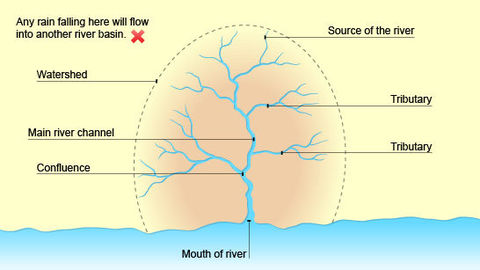Geography - River processes
- Created by: AkshayLonkar
- Created on: 11-12-18 22:30
Fullscreen
- Rivers begin in upland areas and flow downhill
- The source is where a river begins and where it meets the sea is called the mouth.
- A drainage basin is the area of land drained by a river and its tributaries. It is normally bordered by a ridge of high land called the watershed.

How much load the river transports, deposits or how much erosion takes place is dependant on the river's energy which depends on 2 things:
- Velocity of the river - directly proportional
- Volume of water in the river - directly proportional
Discharge is the amount of water passing a set point on a river (measured in cumecs [cubic metres per second])
The energy is used in 3 ways:
- To keep the river flowing
- The energy left over is used for erosion
- The energy left over is also used for transporting sediment (load).
The rate of erosion and transportation increases with energy. When energy falls, deposition occurs.
Where there is friction, the velocity of the river decreases. That is why, on a cross-section of a river, the area of fastest flow (thalweg) is always in the middle where it is away from the channel bed and banks where there is friction.
Erosion
Erosion is the removal of sediment from the bed and banks of a river.
- Lateral erosion is the sideways erosion of the river…
Comments
No comments have yet been made